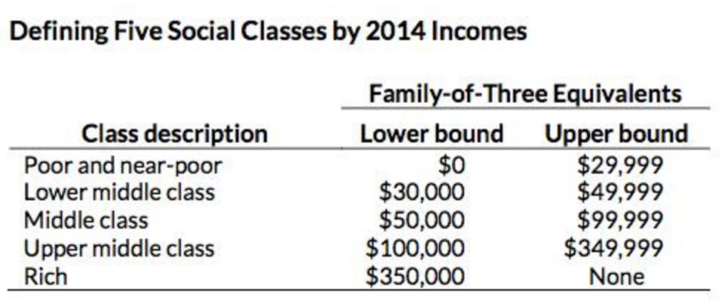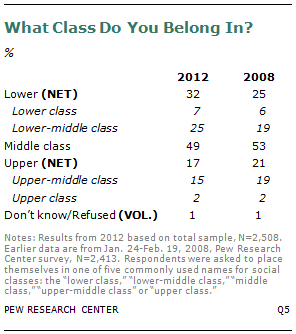- What this actually means economically is a mixed bag, but 'middle class' in the U.S. Has historically stood for something less concrete: the American dream. Between now and the election, All Things.
- The middle class is generally made up of people who fit some combination of the three. (This is not to say, for instance, that every 45-year-old black college grad is middle class.) The Fed.
However, even if there’s no way to settle on a single, clear definition of “middle class,” it’s still possible to sort out the multiple layers of meaning that go into the term. As the 2012 U.S. News article shows, the concept of class is linked to income and wealth, but it also includes education and the kind of work you do. Middle-class meaning A social and economic class lying above the working class and below the upper class.

In developed nations across the world, the lower middle class is a subdivision of the greater middle class. Universally, the term refers to the group of middle class households or individuals who have not attained the status of the upper middle class associated with the higher realms of the middle class, hence the name.[1][2][3][4][5][6][7][8]
United States
In American society, the middle class may be divided into two or three sub-groups. When divided into two parts, the lower middle class, also sometimes simply referred to as 'middle class', consists of roughly one third of households, roughly twice as large as the upper middle or managerial class. Common occupation fields are semi-professionals, such as lower-level managers, small business owners and skilled craftsmen. These individuals commonly have some college education or perhaps a Bachelor's degree and earn a comfortable living. Already among the largest social classes, rivaled only by the working class, the American lower middle class is diverse and growing.[9][10]
Though not common in sociological models, the middle class may be divided into three sections in vernacular language usage. In this system the term lower middle class relates to the demographic referred to as working class in most sociological models. Yet some class models, such as those by sociologist Leonard Beeghley, suggest the middle class to be one cohesive socio-economic demographic, including the demographics otherwise referred to as lower, simply middle or upper middle class in one group comprising about 45% of households.[11]

Social class in the US at a glance[edit]
| Dennis Gilbert, 2002 | William Thompson & Joseph Hickey, 2005 | Leonard Beeghley, 2004 | |||
|---|---|---|---|---|---|
| Class | Typical characteristics | Class | Typical characteristics | Class | Typical characteristics |
| Capitalist class (1%) | Top-level executives, high-rung politicians, heirs. Ivy League education common. | Upper class (1%) | Top-level executives, celebrities, heirs; income of $500,000+ common. Ivy league education common. | The super-rich (0.9%) | Multi-millionaires whose incomes commonly exceed $350,000; includes celebrities and powerful executives/politicians. Ivy League education common. |
| Upper middle class[1] (15%) | Highly-educated (often with graduate degrees), most commonly salaried, professionals and middle management with large work autonomy. | Upper middle class[1] (15%) | Highly-educated (often with graduate degrees) professionals & managers with household incomes varying from the high 5-figure range to commonly above $100,000. | The rich (5%) | Households with net worth of $1 million or more; largely in the form of home equity. Generally have college degrees. |
| Middle class (plurality/ majority?; ca. 46%) | College-educated workers with considerably higher-than-average incomes and compensation; a man making $57,000 and a woman making $40,000 may be typical. | ||||
| Lower middle class (30%) | Semi-professionals and craftsmen with a roughly average standard of living. Most have some college education and are white-collar. | Lower middle class (32%) | Semi-professionals and craftsmen with some work autonomy; household incomes commonly range from $35,000 to $75,000. Typically, some college education. | ||
| Working class (30%) | Clerical and most blue-collar workers whose work is highly routinized. Standard of living varies depending on number of income earners, but is commonly just adequate. High school education. | ||||
| Working class (32%) | Clerical, pink- and blue-collar workers with often low job security; common household incomes range from $16,000 to $30,000. High school education. | Working class (ca. 40–45%) | Blue-collar workers and those whose jobs are highly routinized with low economic security; a man making $40,000 and a woman making $26,000 may be typical. High school education. | ||
| Working poor (13%) | Service, low-rung clerical and some blue-collar workers. High economic insecurity and risk of poverty. Some high school education. | ||||
| Lower class (ca. 14–20%) | Those who occupy poorly-paid positions or rely on government transfers. Some high school education. | ||||
| Underclass (12%) | Those with limited or no participation in the labor force. Reliant on government transfers. Some high school education. | The poor (ca. 12%) | Those living below the poverty line with limited to no participation in the labor force; a household income of $18,000 may be typical. Some high school education. | ||
| |||||
Usage in popular culture[edit]
The lower-middle class is frequently portrayed in television and film. Notable examples include the television shows The Simpsons, Malcolm in the Middle, Married... with Children, 2point4 children, The Middle, Family Guy, Family Matters and Veronica Mars as well as films such as Lady Bird and Soul Food.
See also[edit]

References[edit]
- Notes
- ^The New York Times. 15 May 2005 https://www.nytimes.com/packages/html/national/20050515_CLASS_GRAPHIC/index_01.html. Retrieved 23 November 2011.Missing or empty
|title=(help) - ^Brooks, David (17 November 2008). The New York Timeshttps://www.nytimes.com/2008/11/18/opinion/18brooks.html. Retrieved 23 November 2011.Missing or empty
|title=(help) - ^Decca Aitkenhead (19 October 2007). 'Class rules'. The Guardian. UK. Retrieved 23 November 2011.
- ^Andy Beckett (24 July 2010). 'Is the British middle class an endangered species?'. The Guardian. London. Retrieved 23 November 2011.
- ^Johnson, Reed (31 May 2009). Los Angeles Timeshttp://www.latimes.com/entertainment/news/la-ca-africanamerican31-2009may31,0,7855305.story. Retrieved 23 November 2011.Missing or empty
|title=(help) - ^The Wall Street Journal. 19 August 2010 https://blogs.wsj.com/economics/2010/08/19/much-of-indian-middle-class-is-almost-poor/. Retrieved 23 November 2011.Missing or empty
|title=(help) - ^Weisman, Jonathan (26 March 2010). The Wall Street Journalhttps://www.wsj.com/articles/SB10001424052748704094104575143951112969586. Retrieved 23 November 2011.Missing or empty
|title=(help) - ^Connors, Will (18 January 2011). The Wall Street Journalhttps://www.wsj.com/articles/SB10001424052748704515904576076622892749928. Retrieved 23 November 2011.Missing or empty
|title=(help) - ^Gilbert 2008.
- ^Thompson & Hickey 2004.
- ^Beeghley, L. (2004). The Structure of Social Stratification in the United States. Boston, MA: Allyn & Bacon, Pearson.
- Bibliography
- Bailey, Peter (1999). 'White Collars, Gray Lives? The Lower Middle Class Revisited'. Journal of British Studies. 38 (3): 273–290. doi:10.1086/386195. JSTOR176057.
- Felski, Rita (2000). 'Nothing to Declare: Identity, Shame, and the Lower Middle Class'. PMLA. 115 (1): 34–45. JSTOR463229.
- Gilbert, Dennis L. (2008). The American Class Structure in an Age of Growing Inequality (7th ed.). Thousand Oaks, CA: Pine Forge Press. ISBN978-1-412-95414-3.
- Marx, Karl; Engels, Friedrich (1969) [1848]. 'Manifesto of the Communist Party'. Marx/Engels Selected Works, Volume I (pp. 98–137). Moscow: Progress Publishers.
- Mayer, Arno J. (1975). 'The Lower Middle Class as Historical Problem'. The Journal of Modern History. 47 (3): 409–436. doi:10.1086/241338. JSTOR1876000.
- Thompson, William E.; Hickey, Joseph V. (2004). Society in Focus (5th ed.). London: Pearson. ISBN978-0-205-41365-2.
- Wiener, Jonathan M. (1976). 'Marxism and the Lower Middle Class: A Response to Arno Mayer'. The Journal of Modern History. 48 (4): 666–671. doi:10.1086/241489. JSTOR1880197.
Lower Middle Class Meaning
Middle Class vs Working Class
Middle class and working class are two groups of people who are in different levels of the social hierarchy due to their differing levels of education, values, lifestyles, jobs, and social grouping. The middle class is between the upper class and working class and the working class is just above underclass. There are a number of differences between the types of people that are included in these types of social groups. The article offers a clear explanation on each type of socio-economic classes and explains the differences between middle and working class.
Middle Class
Middle class is defined as a set of people who rank in the mid-section of a society’s hierarchy. This group of people usually falls in between the working class and the upper class in a socioeconomic sense. Individuals such as managers, professionals, academics, lawyers, engineers, doctors, white collar workers, and civil servants are classified as a society’s middle class. It must be noted that careers, which are considered to be middle class, require some tertiary education but do not usually require physical labor. There are a number of factors that contribute in deciding whether an individual belongs to the middle class. These include, tertiary education completion, Holders of professional qualifications, belief in home ownership and secure jobs, values and manners, lifestyle choices, and cultural identification.
Working Class
Working class is defined as those groups of people that are employed in jobs which are considered to be of a lower tier. People in working classes can be found generally in industrialized nations as these individuals are identified as those that create economic value and earn income by non-academic means. Working class workers are also usually those that have jobs that require physical labor. Working class occupations can be divided into 4 categories, outworkers, laborers, artisans, unskilled factory employees. According to Karl Marx (a Prussian-German socialist) working class is the group of people that offer their labor in exchange for wages and generally work for someone else as they do not own the factors of production.
Upper Middle Class Meaning

What is the difference between Middle Class and Working Class?
Middle class and working class refer to two groups of people who are separated in the social hierarchy due to the nature of their jobs, education, values, lifestyles, etc. Working class and middle class are terms that are used frequently when discussing politics, economics and socio-economic conditions in a country. There are a number of differences between the two. Middle class refers to individuals who have had some form of tertiary education and professional qualifications. They are usually doctors, teachers, accountants, lawyers, engineers, academics, etc. Such jobs require some form of additional education (college and professional qualifications) and do not require physical labor. The working classes are those that are employed as laborers, workers, artisans, etc. While these jobs do not require any secondary education they require physical skills, strength and talent. The main difference between the two, however, does not lie in their income levels but rather in their social grouping, education, and occupations. For example in the USA, an occupation that is traditionally considered working class such as brick masons receive roughly $47,000 per year whereas a job that is considered middle class such as a teacher’s assistant, lab technician and optician earn between $23,000 and $33,000.
Upper Middle Class Meaning In Tamil
Summary:

Middle Class vs Working Class
• Middle class is defined as a set of people who rank in the mid-section of a society’s hierarchy.
• Working class is defined as those groups of people that are employed in jobs which are considered to be of a lower tier.
• Middle class refers to individuals who have had some form of tertiary education and professional qualifications and are in jobs that require some form of additional education (college and professional qualifications) and do not require physical labor.
• The working classes are those that are employed as laborers, workers, artisans, etc. While these jobs do not require any secondary education they require physical skills, strength, and talent.
Related posts:




